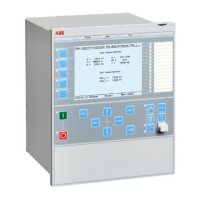
 Loading...
Loading...
Do you have a question about the ABB RED670 and is the answer not in the manual?
| Rated Frequency | 50/60 Hz |
|---|---|
| Product Type | Protection Relay |
| Rated Voltage | 100-240 V AC/DC |
| Communication Protocols | IEC 61850, IEC 60870-5-103, DNP3 |
| Operating Temperature Range | -25°C to +55°C |
| Protection Functions | Differential protection, distance protection, overcurrent protection |
| Outputs | Binary outputs |
| Enclosure | IP54 |
| Mounting | 19" rack mounting |
Provides instructions on commissioning the IED, testing external circuitry, parameter setting, and verification by secondary injection.
Describes safety symbols like general warnings, laser product warnings, and hot surface warnings.
Provides crucial warnings regarding electrical safety, personnel qualifications, and hazardous voltages during operation.
Details precautions for connecting the power supply and checking voltage range and polarity.
Explains how to establish communication using Ethernet and TCP/IP, including setting up IP addresses.
Provides guidelines for checking current transformer circuits, including wiring, polarity, resistance, and excitation tests.
Details checks for voltage transformer circuits, including wiring, polarity, earthing, phase relationship, and insulation resistance.
Details the configuration of analog input channels, especially CT settings, for accurate measurement and protection.
Provides steps to set PMU Connection Tester parameters for establishing IEEE C37.118 connection.
Lists IED test requirements, including settings, configuration diagrams, and necessary test equipment.
Describes how to put the IED into test mode to block protection functions and enable testing.
Guides on verifying analog input values by injecting current and voltage, and checking service values on HMI.
Explains that each protection function must be tested individually by secondary injection, verifying levels, timers, and signals.
Describes the concept and methods (LHMI, PCM600, TESTMODE block) for forcing binary signals.
Details testing procedures for various differential protection functions, including high impedance and line differential.
Covers testing procedures for impedance protection functions like distance protection zones and phase selection.
Provides detailed steps for testing various current protection functions, including overcurrent and earth fault protection.
Guides on testing directionality of distance protection using information from ZMFPDIS, ZMFCPDIS, ZDRDIR, or ZDMRDIR functions.
Covers verification of protection functions, circuit checks, and final directional function verification.
Emphasizes checking the trip circuit health for correct protection operation, especially if trip-circuit supervision is absent.
Guides on navigating menus to find the cause of internal failures indicated by the HMI flashing green LED.
Explains how to interpret internal fault indications on the HMI and retrieve detailed information from the SMS part.
Provides safety warnings and procedures for disassembling and reassembling the IED, including handling ESD-sensitive components.